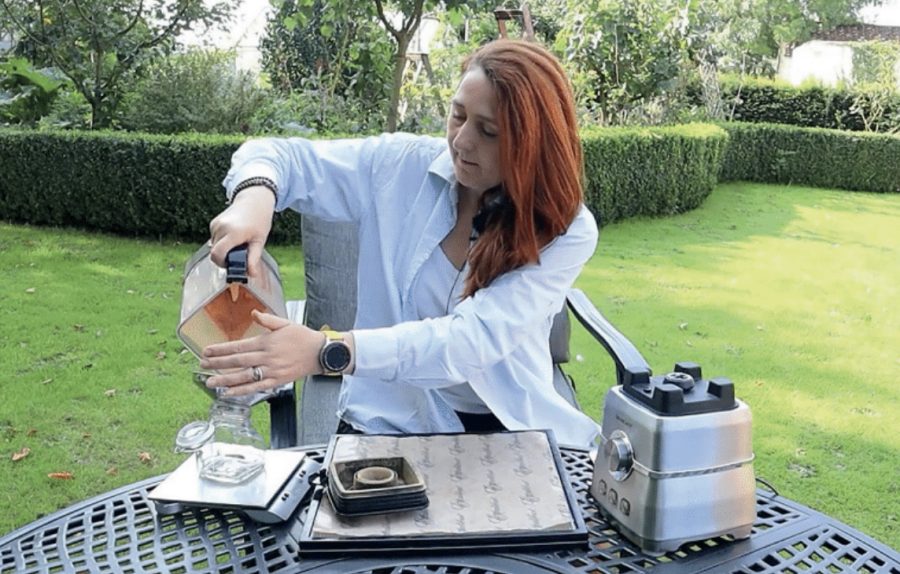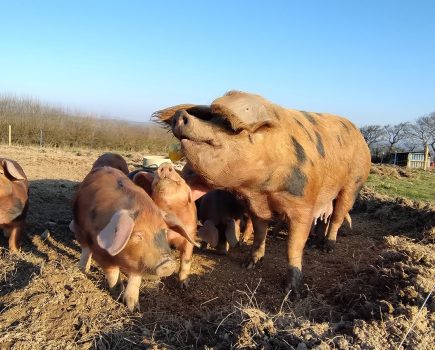Fiona and Hugh Osborne explain how to preserve fruit, vegetables, spices and even meat by drying; an ancient technique with increasing modern relevance.
When we set out to produce as much of our own food as possible, we seriously underestimated what was involved in storing it. Of course, we eat seasonally but honestly, we want to eat fruit, meat and vegetables all year round. Without preserving (and a lot of preserving), that really isn’t possible. We preserve food in many different ways, not only to avoid having more freezers than Iceland, but also because we find different preserving methods suit different types of food.
Frozen strawberries become mushy when defrosted, but dried strawberry slices are fantastic when added to porridge or home-made yoghurt. Once we started dehydrating food we realised what a fantastically versatile and flexible preserving method it is for us.
We don’t just dry fruit, we make a huge variety of space-saving and delicious foods. Dried apples in a Kilner jar last for several years and take up very little room. Chilli powder and flakes are familiar, but tomato powder is fantastic for thickening a Bolognese, making a sauce for a home-made pizza or reconstituting into a tomato puree! Dehydrating has become integral to how we fill our pantry – not just because it’s effective, but because it produces incredible tasting food!
THE SCIENCE
“Dehydrating” (drying) food removes moisture from the food so bacteria, mould and other microorganisms cannot spoil it. Once food is dried thoroughly, if stored in an airtight container (to prevent it absorbing atmospheric moisture), it can last for months or even years. Many people worry whether home dried food is safe to eat, but the same people happily consume dried herbs that are several years old, cereal with dried fruit in it as well as dried mashed potatoes, lentils, pasta and rice.
Drying your own food works in much the same way, when you open a jar, if the contents smell odd, appear mouldy or look spoiled then discard them but if well kept, they should be absolutely fine. We’ve been eating home dried foods for decades with no ill effects!
HOW TO DEHYDRATE FOOD
There are many ways to dehydrate food. Probably the simplest is just to hang up things like herbs to dry upside down. We hang big bundles of herbs to dry, like peppermint and chamomile which we use in tea. Fiona drinks herbal tea by the gallon and herb teas are quite expensive to buy, use a lot of unnecessary packaging and are very easy to grow, so we do, which vastly reduces our food bills.
It is possible to dry a number of things in this way, for example corn dries very well just hung up in a dry spot. In warmer climes, many foods can be dried this way, sun dried tomatoes spring to mind, but in the UK for many foods, artificial heat is needed. When setting out to dry food, it’s important to remember that the object of the exercise is to dry the food, not cook it.
This requires a low temperature for a longtime. We dry vegetables at 55⁰C, Fruits at55-60⁰C and meat at 70⁰C. Most domestic ovens struggle to maintain such a low temperature but it is possible with “warming ovens” on range cookers or just propping the door open a bit on a normal oven on its lowest setting. If you do find dehydrating useful, it quickly becomes apparent that a dehydrator is the best solution.
DEHYDRATORS
Dehydrators are very simple devices. They have a heater of some sort, a thermostat and a fan to blow away moisture as it evaporates. We knew a guy who built a dehydrator for making biltong (dehydrated meat) out of a cardboard box!
He used old 100 Watt light bulbs (remember them?) as the heater, a simple thermostat and a fan from a scrapped computer. He made bars to hang the Biltong on from bamboo canes and S shaped hooks made from fencewire hung the meat. It worked amazingly well, cost almost nothing and produced delicious biltong.
For those of us with less technical confidence at “shed bodgery” dehydrators can be bought to suit most pockets, from under £40 to over £400. We started off with a very basic model and it did very well for a number of years. When it finally wore out Hugh got a very sophisticated model as a Christmas present but, in recent years we’ve found that at times, one simply wasn’t big enough, so we have bought a second basic model for when we have a lot of dehydrating to do.
Budget dehydrators generally have the heater and fan in the base and a number of trays to stack on top of the base with a lid at the very top. They work well, but it’s advisable to reverse the order of the trays during drying because the air does cool and become more moisture laden as it rises, meaning that the bottom trays dry faster. More expensive dehydrators are built like a cabinet full of shelves. The heater and fan are at the back and blow air over the shelves and out the front. This gives a more even drying action.
If you are going to buy a dehydrator, do get one that has both a timer and a variable thermostat. Many items take 12 or more hours to dry and its very handy to be able to set a timer and leave it! A thermostat lets you select the right temperature for food but also, on larger cabinet models, you can use the cabinet without shelves for proving dough or making yoghurt.
FOODS TO DRY
Our plan was to dehydrate foods in times of glut in order to enjoy them when they wouldn’t otherwise be available. A great example of this is apples. We have planted a substantial orchard with many varieties of apple. Whilst we selected some of these apples for their excellent keeping qualities, none last much beyond April. This leaves us with a lack of apples during the “hungry gap” until the following harvest and this is where dried apples come in. Every year we dehydrate approximately 10 big jars of apples as apple rings or pieces.Ways that we can use our dehydrated apples are vast. Put the pieces in a pan with water, bring to the boil and we have stewed apple or apple sauce. Soak overnight and there is sliced apples for a pie. Add them dry to porridge oats with a shake of cinnamon and cook up together and there is a delicious breakfast. They are very versatile and if dried to a leather consistency a great snack “as is”. Dried hard and crisp they will last for three years but do need to be rehydrated before eating. This is a good rule for dehydrating, the drier you make it, the longer it will last.
One tool we do use extensively in preparing apples is a peeler/corer/slicer machine. If preparing 50 apples at a time for dehydrating, it’s a must have! Some fruits dry incredibly well whole, such as raspberries. When we first dried them, we were simply blown away. The texture changes as the water is removed and they become like a meringue and at the same time the flavour intensifies! That was a great lesson and one that we now use to great effect whenever we see pineapples on special offer. Pineapple chunks dried to a chewy texture last for many months and area taste explosion! Most fruits and vegetables benefit from slicing before drying. The apple slicer does a great job of producing even slices but for things like strawberries a mandolin and a cut proof glove (ask us how we know!) come in handy.
Some fruits don’t dry well whole orsliced (gooseberries and rhubarb spring to mind), but there is a way to prepare them that is delicious. Thinly slice your fruit and then stew it to a thick paste (adding a sweetener if you wish) blending it to a puree with a stick blender. Line the mesh shelves of your dehydrator with non-stick “dehydrator sheets” (you can buy these or make your own from a number of materials like Teflon oven liner). Spread your fruit puree on the sheets and then dry until it forms a fruit leather. You can slice this into strips and roll it up, then store it in a jar. These make amazing healthy snacks for kids and adults alike, similar to the fruit rollups sold in shops that are very expensive.
By blending fruits like strawberry and rhubarb you can produce leathers needing no artificial sweetener and sharper fruits like gooseberry make delightfully sour tastes, just like sour sweets. Another way to use a dehydrator is to dry sliced items such as onions or tomatoes and then pulse them in a blender to make a powder. Tomato powder is unbelievably versatile as mentioned above but onion powder is fantastic too, especially when used in home baked bread. Its very easy to produce spices like chilli powder, homemade gravy powders and much more.
If you are sure of your fungi and pick wild mushrooms, producing your own dried mushrooms is a great way of preserving them. We aren’t experts by any means but know enough to safely identify some delicious varieties such as Morels which we saw for sale dried recently at over 50p a gram!
Some people are horrified by the thought of eating dried meat but to others jerky and biltong are an expensive treat. We work on the principle of only drying meats that are safe to eat uncooked so principally venison and beef (although we know someone who really likes dried fish – there’s no accounting for taste)!
Our jerky method is to use very lean cuts of meat and then cut it into thin strips against the grain so that it flakes easily when chewed. We marinate the strips for 24 hours in chilli, soy sauce, garlic and honey and then dry until tough and leathery. The jerky lasts for months (in theory – if you can resist it that long) and is a lean, healthy snack we often take on our long country walks.
DEHYDRATORS ARE A SMALLHOLDER’S FRIEND
Twenty-five years ago, we couldn’t imagine needing a dehydrator. These days one dehydrator isn’t enough, they are amazingly useful when you grow your own food and need to preserve it. They come into their own when stored foods need help – onions starting to sprout? Make dried onion flakes. Glut of plums? Make your own dried fruit and bake cake and Christmas pudding with it! Now that we have learned to use them well, we also produce foods that either aren’t available commercially or are prohibitively expensive. If you do have a large garden, smallholding or allotment, we really do recommend putting a dehydrator on your Christmas list!
Want to know more? – talk to Hugh and Fiona on social media:
www.youtube.com/EnglishcountryLife
https://www.instagram.com/engcountrylife/
Picture caption: Fiona making tomato powder in the summer
To receive regular copies of The Country Smallholder magazine featuring more articles like this, subscribe here.
For FREE updates from the world of smallholding, sign up for The Country Smallholder newsletter here.








